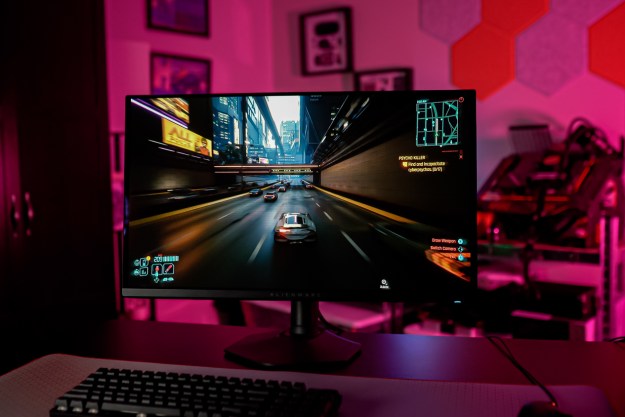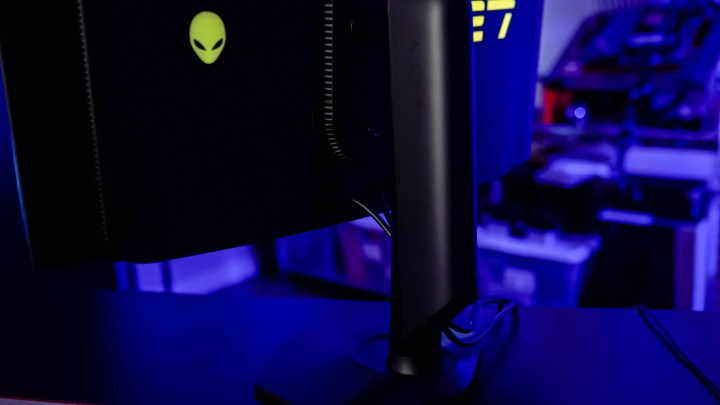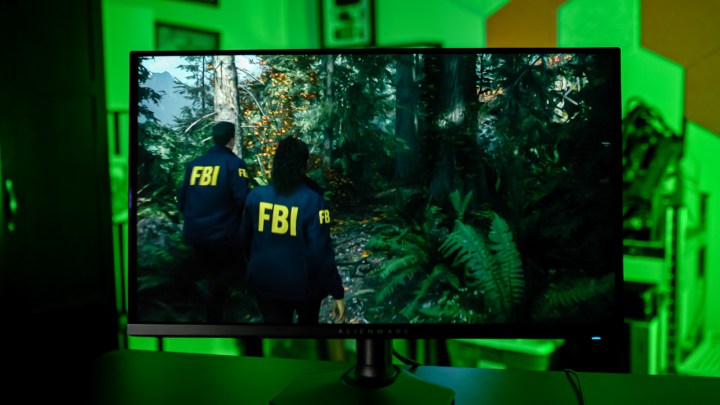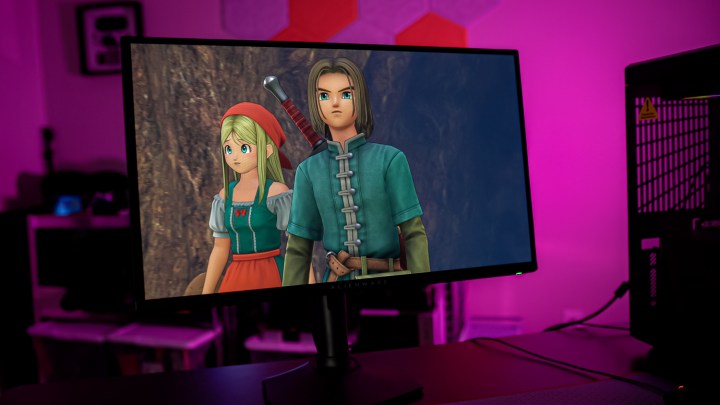
- Exceptional image quality
- Speedy 360Hz refresh rate
- Much-improved color accuracy
- Great cable management solution
- Unmatched OLED warranty
- Bezels are a bit thick
- Smart HDR requires a bit of tweaking
Alienware painted itself into a corner. The Alienware 34 QD-OLED has been the best gaming monitor you can buy for nearly two years, even amid a sea of competition. The new Alienware 27 QD-OLED begs the question: How do you top yourself?
Thankfully, the new 27-inch display comes with answers to that question. Third-gen QD-OLED tech provides a big boost to color accuracy out of the box, all while delivering the searing brightness that QD-OLED displays are known for. Coupled with a higher refresh rate and a lower price, it’s hard to find many downsides with the 27 QD-OLED. It’s a monitor that impresses on nearly every front.
Video review
Alienware 27 QD-OLED (AW2725DF) specs
| Alienware 27 QD-OLED (AW2725DF) | |
| Screen size | 27 inches |
| Panel type | QD-OLED |
| Resolution | 2560 x 1440 |
| Peak brightness | 1,000 nits (HDR) |
| HDR | DisplayHDR True Black 400 |
| Local dimming | 3,686,400 zones |
| Contrast ratio | 1,500,000:1 |
| Response time | 0.03ms (GtG) |
| Refresh rate | 360Hz with AMD FreeSync Premium Pro and Adaptive Sync |
| Curve | N/A |
| Speakers | N/A |
| Inputs | 2x DisplayPort 1.4 (1440p at 360Hz), 1x HDMI 2.1 (1440p at 144Hz) |
| Ports | 3x USB-A 3.2 Gen 1, 1x USB-C 3.2 Gen 1 |
| List price | $900 |
Striking design

I don’t know how Alienware manages to make such an understated monitor look so good. Unlike the original 34 QD-OLED, this monitor comes in the Dark Side of the Moon color (translation: it’s black). There’s minimal branding on the front, just an Alienware logo stretched out across the bottom bezel, but the lack of plastic around the other bezels adds a premium feel that you typically only find on other OLED monitors.
A big reason I like the design so much is the stand. It has a hexagonal base that barely takes up any desk space while still feeling sturdy. The stand does double duty as a routing channel for your cables, allowing you to pass them up through the bottom for a clear desk setup. It’s a far cry from the cable management solution on something like the Samsung Odyssey Neo G8.

After running your cables through the stand, they connect under the back side of the monitor. Alienware recesses the connections so everything stays hidden, and it includes a plastic shell that can cover your connections. It’s very easy to get a clean desk with the Alienware 27 QD-OLED, which is great to see.
As for the stand itself, you have a lot of adjustments to chosse from. There’s 110mm of height adjustment, 26 degrees of tilt, 40 degrees of swivel, and 180 degrees of pivot. That’s only to one side or the other, but you can turn the monitor vertical if you want. In addition, there’s a 100 x 100 VESA mount, so you can throw the monitor on an arm or wall mount if you want to ditch the stand.
The whole package here looks great.
Around the back, Alienware includes an illuminated “27” and Alienware logo, which you can customize with different colors individually through the on-screen display (OSD). They’re super bright, offering a nice bit of bias lighting.
The whole package here looks great with Alienware’s minimal branding and clean cable management solution, but I have a gripe with the bezels. They’re almost a half-inch think, which is a definite downgrade compared to the other 27-inch OLEDs we have like the Asus ROG Swift PG27AQDM. You forget about them after a while, but they were the first thing I noticed upon booting up the monitor.
A solid port selection

Alienware provides a very familiar port selection on the 27 QD-OLED. You have a pair of DisplayPort 1.4 connections underneath the monitor, along with a single HDMI 2.1 port. It’s important to note that only the DisplayPort connections support the full 360Hz refresh rate. HDMI tops out at 144Hz, and the extra port is mainly there if you want to connect a console to the display (both Xbox Series X and PS5 support proper 1440p).
There’s a single USB-B upstream port that opens up the integrated USB hub. There are two USB 3.2 Gen 1 ports alongside the other connections, but Alienware also includes two under the front of the monitor so you can quickly connect and disconnect peripherals. These ports are split across a USB-A and a USB-C port, but both use 3.2 Gen 1 for data transfer. Note that the USB-C connection doesn’t support DisplayPort Alt mode, so it’s not considered a monitor input.
How you improve the best

At this point, you don’t need me to tell you that OLED monitors look stunning. From the Samsung Odyssey OLED G9 to the LG UltraGear OLED 27, you’re getting a stunning image, and the 27 QD-OLED doesn’t change that. My main question going into this review was how Alienware would capitalize on third-gen QD-OLED tech, and it definitely did.
That mainly comes down to color accuracy. It’s exceptional on the 27 QD-OLED. In the standard picture profile, I measured an average Delta-E of 0.46 with my Spyder X2 colorimeter in the default picture profile, which is the best result I’ve ever recorded for overall color accuracy. It’s great, but there’s a little more nuance to this conversation.
With the 34 QD-OLED, we noticed the green primary was out of whack across the board, with blue joining it past 600 nits. That’s not the case here. The reds are a little hot, but they scale in a much more linear way across the brightness spectrum. And Alienware includes a dense set of tools to adjust these colors through the on-screen display.

Brightness is excellent as well, but there isn’t much new here. I measured a peak brightness of 928 nits in HDR for a 1% window. Naturally, that drops as the window size increases. It dropped to 837 nits for a 4% window, and down to 474 nits for a 10% window. This is excellent brightness. I also measured perfect black levels, as you’d expect from OLED, so the contrast is infinite.
The only note here, however, is that I only achieved this level of brightness with the HDR Peak 1000 mode. Alienware includes about a half dozen Smart HDR presets that tweak the contrast, saturation, and color balance. You have a custom preset available, too, and if you have the patience for tweaking, it’s definitely the one I’d recommend.
The color accuracy is much better out of the box.
The reason being is that it was hard for me to settle on one of the Smart HDR presets. The default desktop mode looked a bit blurry compared to the others, while the movie mode raised the black levels too much and the game mode was oversaturated. Desktop mode is the best balance of color and contrast to my eyes, but I’d definitely take the custom mode if you don’t mind tweaking.

I would not recommend turning off Smart HDR, though. In a proper HDR game, it looks terrible, with overblown highlights, way too much saturation — the list goes on. Keep Smart HDR on, even if it’s just the desktop mode.
Alienware already had a very solid foundation for image quality, but the 27 QD-OLED manages to address the big pain point of its previous attempt at OLED. The color accuracy is much better out of the box, making it easier to get a color-accurate image if you need it. As usual, however, consumer OLED gaming monitors are built for media consumption, not creation. If that’s your primary focus, you’re better off with a highly accurate IPS panel.
Speed and quality in equal measure

The image quality is great, but you’re going to buy the 27 QD-OLED for gaming. Thankfully, it’s just as impressive on that front. OLED provides near instantaneous response times, which when combined with the super-high 360Hz refresh rate, makes your games feel impossibly smooth on the 27 QD-OLED.
I’d normally write off such a high refresh rate. It’s great for the Overwatches and Counter-Strikes: Global Offensives of the world, but you’d never be able to capitalize on that high of a refresh rate in other titles. However, we’re living in a time of upscaling and AI-generated frames, allowing you actually take advantage of how fast the 27 QD-OLED is.

Returnal is a great example. I booted it up on an RTX 4080 PC, and with DLSS 3 running, I was getting in the range of 280 to 290 frames per second (fps) with Ultra settings. No, you’re not always going to get that high, but with modern games, you can actually use a 360Hz refresh rate outside of just competitive esports titles.
And man, does it feel responsive. With the low response times of OLED and the high refresh rate, gameplay feels silky smooth. It makes Alienware’s 500Hz gaming monitor it released last year look silly, frankly. Now, you’re getting the responsiveness and clarity of an esports display while also getting the inky blacks necessary for high-end cinematic gaming.

Don’t discount that cinematic experience, either. This is still a QD-OLED gaming monitor, so when playing games like Alan Wake 2 and Cyberpunk 2077, you’re getting the most immersive experience money can buy. The only displays that are better are other OLED monitors, such as the Odyssey OLED G8 or Alienware’s own 34 QD-OLED.
With the high refresh rate, however, the Alienware QD-OLED 27 carves out its own space in the growing market of OLED options. It nails the color and contrast for cinematic HDR gaming, and it packs a speedy refresh rate that makes games look smooth. It’s excellent.
How Alienware leads the market

You should buy the Alienware 27 QD-OLED, let’s make that clear. Even if it came in at the same $1,000 price that last year’s 27-inch OLED displays launched at, it’s still the monitor to buy. Alienware isn’t charging that price, though. It actually manages to undercut the competition from last year at $900, which is all the better considering its refresh rate.
Alienware is carrying its excellent warranty forward, too. Like the 34 QD-OLED, you get a three-year warranty with the 27 QD-OLED, and that covers burn-in. OLED burn-in is a risk, even if it’s an overblown risk. You might never have to take advantage on the warranty, but it’s good to have that peace of mind without having to go out of pocket for an extended warranty.
Alienware has a market-leading warranty here.
It’s something that other monitor brands aren’t offering. Either burn-in isn’t covered, or the warranty only lasts for a year, and sometimes both. Alienware has a market-leading warranty here, and it’s one of the key reasons to choose this display over other options.
The QD-OLED monitor to buy

This is a display with very few downsides. You’re getting better QD-OLED tech with a higher refresh rate for less money than what we saw last year. And with a market-leading warranty that covers burn-in. Sure, the bezels are a little too thick and you might be able to find one of last year’s OLEDs on sale for a bit cheaper, but those are about all of the cons I can muster.
As impossible as it seemed, Alienware took what made the 34 QD-OLED so excellent and addressed the few pain points that the display had, particularly in terms of refresh rate and color accuracy. Alienware topped itself, and barring any major shake-up, it might sit atop the list of the best gaming monitors for another two years.






